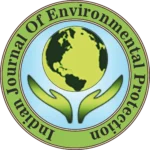IJEP 44(5): 405-411 : Vol. 44 Issue. 5 (May 2024)
D.O. Babadele1, O.G. Dayo-Olagbende2*, B.S. Ewulo3 and M. Aminu3
1. Olusegun Agagu University of Science and Technology, Department of Crop, Soil and Pest Management, School of Agriculture and Food Technology, Okitipupa, Ondo, Nigeria
2. Afe Babalola University, College of Sciences, Department of Agricultural Sciences, Ado-Ekiti, Nigeria
3. Federal University of Technology, Department of Crop, Soil and Pest Management, School of Agriculture and Agricultural Technology, Akure, Ondo, Nigeria
Abstract
Nutrient leaching poses a significant challenge, particularly in tropical regions characterized by high rainfall, leading to diminished soil fertility and environmental contamination. This study seeks to explore the efficacy of cow dung biochar in mitigating nutrient leaching. The experimental design utilized a completely randomized design (CRD) with three replications. The investigation encompassed four treatments: a control, NPK 15:15:15 fertilizer application, sole biochar incorporation and a combination of NPK and biochar. Collected data encompassed parameters, like pH, soil texture, nitrogen, phosphorus and exchangeable cations. Statistical analysis was performed through ANOVA using SPSS 2017, while Tukey HSD was employed to discern means at a 5% significance level. Microsoft Excel 2016 was used to generate graphs and charts. Post-experimental soil and leachate analyses revealed diminished nitrogen and potassium leaching in biochar-treated scenarios. Calcium and magnesium leaching were most subdued in both control and biochar-treated soils. In conclusion, incorporating biochar into soil exhibits promise for curtailing nutrient loss via leaching, thereby reducing environmental pollution. This approach holds potential for enhancing soil fertility, bolstering productivity, reducing environmental pollution and aiding carbon sequestration to combat climate change. These findings hold significant implications for formulating policies aimed at environmental enhancement, sustainable soil management and conservation strategies.
Keywords
Nitrogen, Leachates, Exchangeable cations, Phosphorus
References
- Archer, S. 2010. Rangeland ecosystems: Processes, management and challenges. J. Arid Env., 74(10): 1327-1331.
- Reynolds, J.F., et al. 2007. Global desertification: Building as science for dryland development. Sci., 316 (5826): 847-851.
- Siddique, M.T., et al. 2016. Effect of water stress on nutrient uptake and fertilizer use efficiency in wheat. Soil Env., 35(1): 1-8.
- Balota, E.L. and W.A. Payne. 2006. Fertilizer placement and waters stress effects on maize dry matter and nitrogen. Accumulation Agr. J., 98(5): 1286 -1293.
- Schoumans, O.F., et al. 2009. Assessment of the reduction of nutrients loads to European surface waters resulting from measures implemented under the European nitrate directive. J. Env. Quality. 38(2): 448-458.
- Lehmann, J. and S. Joseph. 2009. Biochar for environmental management. Science and technology. Earthscan, London.
- Woolf, D., et al. 2010. Sustainable biochar to mitigate global climate change. Nat. Commun., 1: 56.
- Jeffery, S., et al. 2011. A quantitatie review of the effects of biochar application to soil on crop productivity using meta-analysis. Agric. Ecosys. Env., 144(1): 175-187.
- Atkinson, C.I., J.D. Fitzgerald and N.A. Flipps. 2010. Potential mechanics for acheiveing agricultural benefits from biochar application to temperate soils: A review. Plant Soil. 337(1-2): 1-18.
- Glaser, B., J. Lehmann and W. Zech. 2002. Ameliorating physical and chemical properties of highly weathered soils in the tropics with charcoal: A review. Biol. Fertility Soils. 35(4): 219-230.
- Laird, D., et al. 2010. Impact of biochar amendments on the quality of typical midwestern agricultural soil. Geoderma., 158(3-4): 443-449.
- Lehmann, J., et al. 2003. Nutrient availability and leaching in an archaecological anthrosol and a ferralsol of the Central Amazon basin: Fertilizers, manure and charcoal amendments. Plants Soil. 249(2): 343-357.
- Spokas, K.A., et al. 2012. Biochar: A synthesis of its agronomic impact beyond carbon sequestration. J. Env. Quality. 41(4): 973-989.
- Lehmann, J. and S. Joseph. 2015. Biochar for environmental management: Science, technology and implementation (2nd edn). Routledge.
- Major, J., et al. 2010. Maize yield and nutrition during 4 years after biochar application to Colombian savama oxisol. Plant Soil. 333 (1-2): 117-128.
- Murphy, J. and J.P. Riley. 1962. A modified single solution method for the determination of phosphate in natural waters. Analytical Chimica Acta. 27: 31-36.
- Galloway, J.N., et al. 2004. Nitrogen cycle: Past, present and future. Biogeochem., 70(2): 153-226.
- He, Y., et al. 2017. Effect of biochar application on soil greenhouse gas fluxes: A meta-analysis. GCB Bioenergy. 9(4): 743-755.
- Liu, Z., et al. 2022. Plastic film mulching and biochar amendment enhance maize yield and nitrogen fertilizer use efficiency by reducing gaseous nitrogen losses. Field Crops Res., 289(1): 108714. DOI: 10.1016/j.fcr.2022.108714.
- Smith, V.H., G.D. Tilman and J.C. Nekola. 1999. Europhication: Impact of excess nutrienton freshwater marine and terrestrial ecosystem. Env. Poll., 100(1): 179.
- Brewer, C.E., et al. 2009. Characterization of biochar from east pyrolysis and gasification system. Env. Progress Sustain. Energy. 28(3):386-396.
- Xu, M., et al. 2019. Biochar addition to soil highly increase P retention and decrease the risk of phosphate contamination of water. Env. Chem. Letter. 17: 533-541. DOI: 10.1007/s10311-018-0802-z.
- Liu, Y., et al. 2016. Impact of biochar addition on rice yield and soil properties in a cold waterlogged paddy for two crop season. Field Crop Res., 191: 161-167.
- Shaaban, M., et al. 2020. Biochar: A sutainable approach for improving soil fertility, potassium uptake and fruit yield of date palm (Pheonix dacrylifera L.) in sandy soil. Agronomy. 10(3): 356.
- Abbasi, K., et al. 2007. Mineralization of three organic manures used as nitrogen source in a soil incubated under laboratory conditions. Communications Soil Sci. Plant Analysis. 38(13-14): 1691-1711. DOI: 10.1080/00103620701435464.
- Zhang, H., et al. 2017. Effect of feedstock and pyrolysis temperature on properties of biochar governing end use efficiency. Biomass Bioenergy. 105: 136-146. DOI: 10.1016/j.biombioe2017.06.024.
